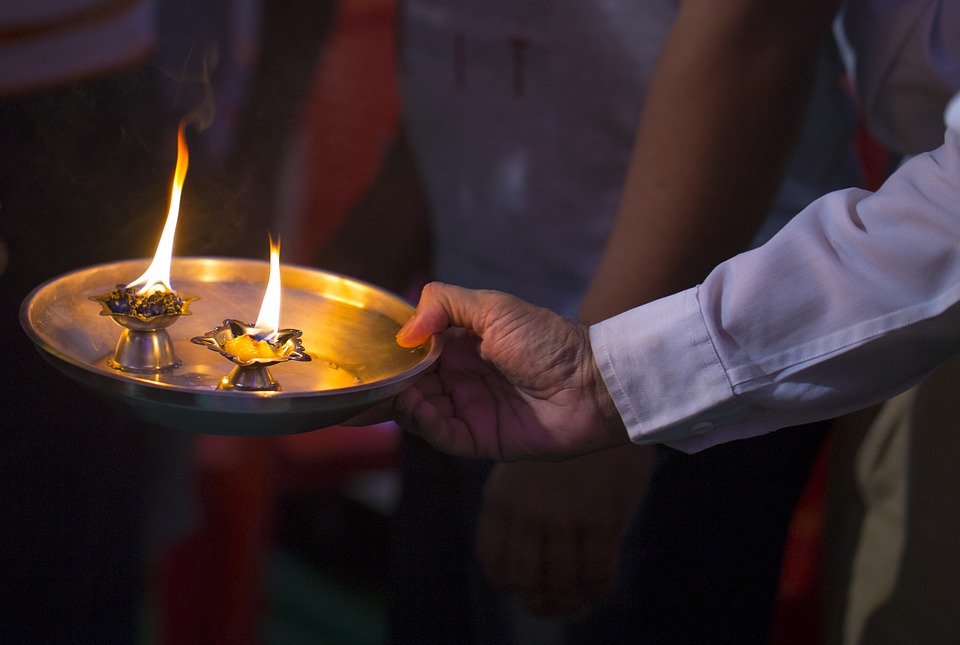Several years ago, while searching for a name for my then unborn daughter, I was particularly attracted by the name “Aarti”. The original intent was to choose a name that would pay homage to my Indian heritage yet would still be functional in the Western world. In retrospect, it is a fitting name for a child whose safe birth after a harrowing pregnancy was a reminder of the significance of an important ritual in Hinduism.
The teachings of Hinduism assert that many thousands of years ago, holy men called sages received divine revelations pertaining to the practice of the religion. These revelations were formally compiled and set down in written form as a set of four scriptures called the Vedas. Written in Sanskrit, the Vedas codify the instructions for the performance of rituals that govern various different aspects of an individual’s life, including the appropriate prayers and songs for each ritual.
The word “aarti” comes from the Rig Veda, one of the earliest Hindu scriptures.
It has many shades of meaning. Some believe that it means the period before the darkness of night sets in. Aarti can also signify “the highest love for God” which results in a state of spiritual joy.
 Many of Hinduism’s religious practices center around the worship of the five elements: fire, water, earth, air, and space, Together the five elements comprise the physical world or universe. Each also corresponds to one of the five physical senses. The element of fire is associated with vision. Darkness is associated with ignorance and impurity, because it obscures clear sight, while the light is the source of life and knowledge.
Many of Hinduism’s religious practices center around the worship of the five elements: fire, water, earth, air, and space, Together the five elements comprise the physical world or universe. Each also corresponds to one of the five physical senses. The element of fire is associated with vision. Darkness is associated with ignorance and impurity, because it obscures clear sight, while the light is the source of life and knowledge.
The aarti evolved from the worship of fire. Fire in Hinduism cleans and purifies. The aarti is the closing ritual of the prayer. Typically, a piece of camphor or a clay or metal lamp with cotton wicks soaked in oil or ghee is placed on a metal plate along with flowers and incense. The lamp or camphor is then lighted. The plate is rotated in a clockwise direction in front of a picture or statue representing the deity whose blessing is being invoked, accompanied by the ringing of a bell and the chanting of devotional hymns. After the prayer is finished, the plate is then taken to all the gathered worshippers who put their hands over the flame and then touch their eyes.
Everything used to do aarti must be in its most natural form since the objective of the ritual is to reach a purer state. The lamp is made of clay or pure natural metal from the earth such as silver, as is the plate. The cotton for the wicks, the flowers, and the camphor are also natural materials. Ghee is clarified butter, in which all solid residue has been melted away until only a pure liquid is left behind. The camphor similarly leaves no residue behind after it burns. The flowers and the incense purify the air with their fragrance. The devotional songs are natural sounds while the bell acts to eliminate any residual sound and focus attention on the prayer.
The lamp represents the individual.
The lighting of the lamp represents spiritual enlightenment through knowledge. A lamp can pass its light on to other lamps just as knowledge can be spread. The flowers and incense bring mental tranquility to the worshippers. The rotations of the lamp or plate represent a continuous link between the individual, the universe, and the divine. The plate is imbued with the divine essence, which subsumes each individual who participates in the ritual. The individual internalizes that essence by passing his hand over the flame and touching his eyes.
The offering of aarti symbolizes the belief that the divine is the ultimate center of all existence and life. By performing the aarti, the worshipper makes an offering to God of his material form, an act of submission of the individual to the divine, leading to a state of the highest joy. Such beliefs are the basis of religion because they create a stable foundation for existence in a turbulent world.






